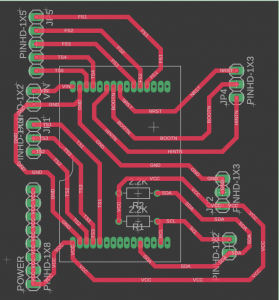This week, I mainly focused on preparing for the final presentation. We compiled all of our data from testing and created tables to show them in the slideshow. Additionally, I compiled a list of trade-offs that we faced throughout the iteration process as well as information on group studies we conducted. After the presentation, I helped create a final poster to show off our design and work throughout the semester, and made some finishing touches to the information presented as well as documenting the complete solution of our product. Next week, we will work on the demonstration as well as finishing up the final design report. We will also gather any information needed for these presentations as well as conduct any more testing necessary to meet design requirements. We are well on schedule for this week.
Sarah’s Status Update 12/2
This week, I mostly focused on getting all of the sensors onto the glove itself. I helped in soldering wires onto the sensors as well as soldering them directly onto the board. I measured roughly and made sure there was enough wire to reach the board on the back of the hand. After this, I tested each sensor to make sure they were still working, and then gave it to a small user group to try out. One of the most concerning responses was that when the user reached up to squeeze the touch sensors, it would accidentally trigger the flex sensors, since the finger naturally bends to touch finger pads with another. I experimented more with the placement of each sensor on the glove, and we decided to move all the sensors down so that the touch sensors were easier to reach and the flex sensors would only trigger with drastic finger flexes. After this, I experimented with actuating certain commands with the sensors, and it worked fairly well. Additionally, I toggled with the thresholds of what we consider a press or not, and mapped them more closely with this new placement of sensors. I also started working on the slides for the final presentation as well as practicing my speech during the presentation. We are currently on schedule and will be able to present next week for the final presentation. Next week, I will work on fine tuning the thresholds and adding a way for the user to calibrate the sensors to their liking.
Sarah’s Status Update 11/18
This week, I worked more on interfacing the sensors with the board. I was able to solder some wires to the sensors to wires for them to connect to the board. Additionally, I did more research on the sensors and their resistance limit. I’m fairly sure the resistors I put in place (10K) will suffice for any amount of combination for sensor resistances, but I will also look into increasing the resistance limit for more calibration purposes. I also explored the layout that we would like to use for the sensor and board placement on the glove. Next week, I will focus on soldering the PCB since it will likely arrive in the next few days, and attaching everything to the glove for a working model. We will also decide on which battery to use, as we would like it to be as light as possible. We are looking into 5V batteries with around 2000mAh since our tests indicated this would be sufficient power for more than 2-3 hours, which was our requirement. We will most likely order a backup battery and connect via usb. We are largely on track for this project and will look into getting more data and running more tests when the board arrives.
Sarah’s Status Update 11/11
This week, we had our interim demonstrations, so I worked on getting ready for that. I set up a breadboard with 4 touch sensors and 3 flex sensors and connected them all to the ESP32. However, the flex sensors’ resistance was too large to be recognized by the ESP. I then added 10K Ohm resistors in parallel for each flex sensor to lower the effective resistance of each flex sensor circuit. Additionally, when combining all the sensors on the same power line, there seemed to be the same problem with too much resistance on each line. I then added 10K Ohm resistors in parallel for each sensor, which seemed to solve our problem. We also received our IMU earlier this week. Since the communication between the ESP and IMU is I2C, I created an I2C scanner to find the peripheral address of the IMU. I then read through the IMU manuals to figure out how to enable and display the readings from each sensor on the IMU. Since the IMU is the only peripheral on the I2C bus, I treated it as a sensor and constantly polled for data. This eliminated the need for interrupts, so the only wires connecting the ESP and the IMU are power, mode selection for the communication protocol, and the data and clock lines. We ended up implementing a library especially designed for the FSM300, which allowed us to print gyroscope and accelerometer readings to the serial display. After adding in the resistors to the demo breadboard, I updated the PCB files to include these added resistors, using SMD 0805 10K resistors. For ease of use and to make our entire footprint smaller, I sent out the files for the PCB to be fabricated, and I expect this order to arrive early next week. I also placed an order for the correct resistors needed as I will do the PCB assembly by hand. Finally, I tested out the battery life needed for the entire system, and found that the battery life lasted for over 15 hours with about 7500 mAh of charge. Next week, I will start assembling the PCB, attaching the sensors to the glove, and do some more stress testing on the battery so we can hopefully order either a small power bank or lithium ion battery for the final project. We are on schedule to finish on time.
Team Status Update
This week, we worked on our ethics assignment and thought about ways in which our product would affect users in an ethical manner. One of the cases we thought about specifically was the situation in which someone could control someone else’s device without their consent. We thought about ways in which we could combat this, including limiting information collected from the user as well as security measures to make sure the user knows exactly which keystrokes do what and the risks that come with using the device. Additionally, we received our IMU this week and soldered jumper cables onto it. We will work next week on creating a demonstration for the class as well as working with the IMU to interface it with the ESP32, specifically implementing communication protocols as well as figuring out how to access information from the device. Some risks that could jeopardize the project are, because we received the IMU somewhat later in the semester due to shipping complications, we need to start interfacing and familiarizing ourselves with the software and calibration techniques that come with the device. No considerable changes have occurred to our design, and we are seemingly on track with the rest of the project.
Sarah’s Status Update 11/4
This week, I worked on polishing the PCB we have for the project. I made the traces larger on the schematic for power routing, and realized that the reason why our PCB kept short circuiting was because it was a two sided PCB. Next steps for next week would be to sand off the bottom of the PCB and solder on the pin headers needed for the board. We received the IMU as well and starting tomorrow I will working on interfacing the main board with the IMU, setting up I2C communication, and figuring out how to derive information from the IMU. Since we already soldered jumper wires to the IMU, I will need to connect the reset, interrupt, power, ground, and communication pins to the ESP32. There were no considerable changes made to our final design, and we are still on track for our final presentation. We will work on patching up our design and creating a demonstration for the interim demos next week.
Sarah’s Status Update 10/28
This week, I focused on creating the schematic, gerber files, and PCB for our project. This was mainly for routing power, connecting the ESP more easily to peripherals, and creating a hub where most of our components lie. I created a schematic on Fusion 360 with female pin headers for the ESP32, and male headers for each of the peripherals to connect to. Then, I used the milling machine in Techspark to create a PCB we could use. Unfortunately, it seems like our board is shorted somewhere, but I have yet to test it extensively to figure out where the short lies. I faced lots of problems with creating this PCB, including:
- The distance between the two pin headers for the ESP32 was too large, so I had to iterate on the design multiple times to make sure the board fit securely.
- I originally routed the PCB to use two sides, but after finding out the PCB milling machine only mills out one side, I had to recreate the board using only one layer. Since there are lots of peripherals, it was hard to find a configuration that didn’t overlap with other traces.
- The milling machine has a large learning curve, so I had to print the PCB at least 6 times before I got the hang of how to use it effectively.
- The milling machine has very specific rules on how close traces can be as well as traces coming out of pin headers, so making sure these rules were followed was also difficult.
Since the board has a short, next week I will focus on figuring out whether the short comes from the PCB itself, or if it is a problem with the schematic I created. In terms of hardware, we are still on schedule with the project, and we are still awaiting arrival for the IMU. Our flex sensors came in the mail earlier last week, so we are also looking forward to testing and connecting these sensors to the ESP3210



Rosina’s Status Update 10/21
This week was assigned as slack week for us. This week I did some more research on the IMU and PyAutoGUI since we hope to receive the IMU component soon and I want to make sure that we’re ready to use it. We are still on schedule. For next week, I hope to start playing around with the IMU and look at the calibration software that is comes with. As for new tools to learn, I primarily want to focus on PyAutoGUI and reading the IMU data.
Sarah’s Status Update 10/21
We figured out we needed a PCB to interface the microcontroller with the sensor peripherals we have as well as the IMU. This week, I started working on the PCB design we need for the board. I created a part on Fusion 360 for the ESP32 development board, as well as a footprint and 3D model. After that, I started working on creating a layout for where we want each peripheral to connect to the board and the power routing for each sensor. Since this week we scheduled for slack, we are still on schedule. We are awaiting arrival of the IMU we ordered so we can start interfacing via I2C and experimenting with the various sensors on the board. In the next week, we hope to receive the IMU, and start interfacing it with the ESP32.
As for new tools we are currently looking into for the project, I am personally looking more into PCB fabrication, specifically using a PCB milling machine to make our new board for interfacing. Hopefully after researching the required software, I will be able to create a PCB that is suitable for our purposes and fits the ESP32 development board correctly.
Team Status Update 10/21
This week was our budgeted slack week as per the Gantt chart. In terms of the risks that our project currently faces, we are a little worried about the shipping time for the IMU and the printing time for our PCB. We ordered the IMU right before break, and we are hoping that it’ll get delivered by the time we get back. As for the PCB, since Techspark was closed this week for break, we couldn’t get a head start on milling our PCB. If we can’t get the PCB milled, we can test with a breadboard until we get the PCB. If the IMU doesn’t arrive, we’ll need to move things around a little to budget more time to play around and code for the IMU. We haven’t made any changes to the design in the past week except deciding to mill the PCB ourselves instead of getting it outsourced.
